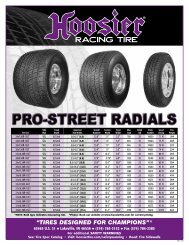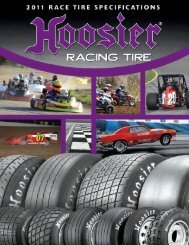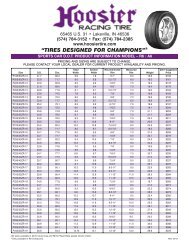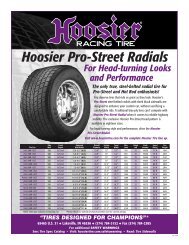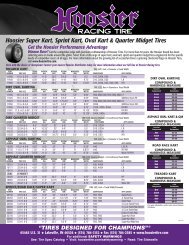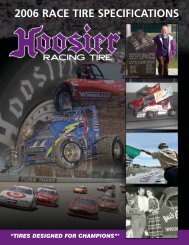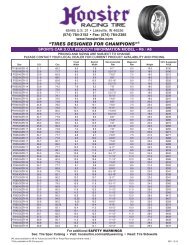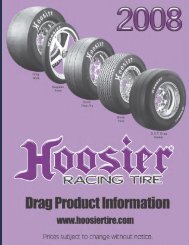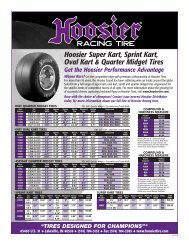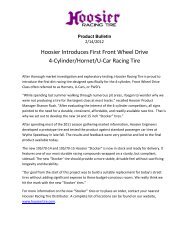in the united states district court for the - Hoosier Racing Tire
in the united states district court for the - Hoosier Racing Tire
in the united states district court for the - Hoosier Racing Tire
You also want an ePaper? Increase the reach of your titles
YUMPU automatically turns print PDFs into web optimized ePapers that Google loves.
Case 2:07-cv-01294-TFM Document 263 Filed 09/15/2009 Page 9 of 34<br />
tracks, as well as modified weekly rac<strong>in</strong>g. UMP had a “<strong>Hoosier</strong> only” rule <strong>for</strong> years, which has<br />
cont<strong>in</strong>ued under DMS’s ownership.<br />
B. Sanction<strong>in</strong>g Bodies <strong>in</strong> <strong>the</strong> Motor Sport Industry<br />
Most dirt oval tracks are owned or leased by owners / promoters, who own or lease<br />
<strong>the</strong> dirt oval tracks and organize and conduct <strong>the</strong> races. Most track owners / promoters are<br />
members of a “sanction<strong>in</strong>g body” <strong>for</strong> at least one class of cars at <strong>the</strong>ir track. A sanction<strong>in</strong>g<br />
body is an organization that <strong>for</strong>mulates and promulgates rules that govern <strong>the</strong> races which <strong>the</strong>y<br />
sanction. Sanction<strong>in</strong>g bodies compete to attract race car drivers (“drivers”) and fans to <strong>the</strong>ir<br />
races. In order to give <strong>the</strong> participants at its track <strong>the</strong> best opportunity to demonstrate <strong>the</strong>ir<br />
skills and encourage participation, a promoter or sanction<strong>in</strong>g body must provide a level play<strong>in</strong>g<br />
field <strong>for</strong> <strong>the</strong> competitors.<br />
The owners / promoters pay a sanction<strong>in</strong>g fee to <strong>the</strong> sanction<strong>in</strong>g body. It is desirable<br />
<strong>for</strong> track owners / promoters to be members of a sanction<strong>in</strong>g body because <strong>the</strong> sanction<strong>in</strong>g body<br />
creates <strong>in</strong>centives <strong>for</strong> drivers to drive <strong>in</strong> <strong>the</strong> races that <strong>the</strong>y sanction. These <strong>in</strong>centives <strong>in</strong>clude<br />
enabl<strong>in</strong>g drivers to accumulate po<strong>in</strong>ts, both nationally and regionally, race publicity, guarantee<br />
purses <strong>for</strong> <strong>the</strong> w<strong>in</strong>n<strong>in</strong>g drivers, and <strong>the</strong> promulgation of rules familiar to <strong>the</strong> race drivers.<br />
Sanction<strong>in</strong>g bodies often choose to utilize a “s<strong>in</strong>gle tire rule,” which requires that a<br />
specific tire type and brand be used on one or more wheel positions (i.e., right-and left-front,<br />
right-and left-rear) <strong>for</strong> one or more classes of cars <strong>for</strong> a series of races or rac<strong>in</strong>g seasons (e.g.,<br />
“spr<strong>in</strong>t cars,” “modifieds,” “hobby stocks,” “sports compacts”).<br />
9



